
Carnotaurus is a genus of theropod dinosaur that lived in South America during the Late Cretaceous period, probably sometime between 71 and 69 million years ago. The only species is Carnotaurus sastrei. Known from a single well-preserved skeleton, it is one of the best-understood theropods from the Southern Hemisphere. The skeleton, found in 1984, was uncovered in the Chubut Province of Argentina from rocks of the La Colonia Formation. Carnotaurus is a derived member of the Abelisauridae, a group of large theropods that occupied the large predatorial niche in the southern landmasses of Gondwana during the late Cretaceous. Within the Abelisauridae, the genus is often considered a member of the Brachyrostra, a clade of short-snouted forms restricted to South America.

Masiakasaurus is a genus of small predatory noasaurid theropod dinosaurs from the Late Cretaceous of Madagascar. In Malagasy, masiaka means "vicious"; thus, the genus name means "vicious lizard". The type species, Masiakasaurus knopfleri, was named after the musician Mark Knopfler, whose music inspired the expedition crew. It was named in 2001 by Scott D. Sampson, Matthew Carrano, and Catherine A. Forster. Unlike most theropods, the front teeth of M. knopfleri projected forward instead of straight down. This unique dentition suggests that they had a specialized diet, perhaps including fish and other small prey. Other bones of the skeleton indicate that Masiakasaurus were bipedal, with much shorter forelimbs than hindlimbs. M. knopfleri was a small theropod, reaching 1.8–2.1 m (5.9–6.9 ft) long and weighing 20 kg (44 lb).
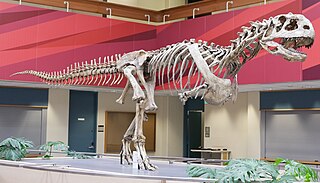
Abelisauridae is a family of ceratosaurian theropod dinosaurs. Abelisaurids thrived during the Cretaceous period, on the ancient southern supercontinent of Gondwana, and today their fossil remains are found on the modern continents of Africa and South America, as well as on the Indian subcontinent and the island of Madagascar. Isolated teeth were found in the Late Jurassic of Portugal, and the Late Cretaceous genera Tarascosaurus and Arcovenator have been described in France. Abelisaurids first appear in the fossil record of the early middle Jurassic period, and at least three genera survived until the end of the Mesozoic era 66 million years ago.

Aucasaurus is a genus of medium-sized abelisaurid theropod dinosaur from Argentina that lived during the Late Cretaceous of the Anacleto Formation. It was smaller than the related Carnotaurus, although more derived in some ways, such as its extremely reduced arms and almost total lack of fingers. The type skeleton is complete to the thirteenth caudal vertebra, and so is relatively well understood, and is the most complete abelisaurid yet described. However, the skull is damaged, causing some paleontologists to speculate that it was involved in a fight prior to death.

Deltadromeus is a genus of theropod dinosaur from the Aoufous Formation of Morocco.
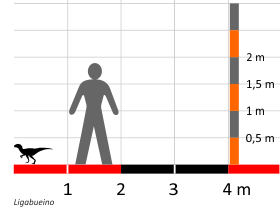
Ligabueino is a genus of noasaurid dinosaur named after its discoverer, Italian doctor Giancarlo Ligabue. It is known only from an extremely fragmentary specimen, measuring 79 cm (2.6 ft) long, found in the La Amarga Formation. In spite of initial reports that it was an adult, the unfused vertebrae indicate that the specimen was a juvenile. It was a theropod and lived during the Early Cretaceous Period, in what is now Patagonia. Contrary to initial classifications that placed it as a member of the Noasauridae, Carrano and colleagues found in 2011 that it could only be placed with any confidence in the group Abelisauroidea.

Abelisauroidea is a diverse superfamily of ceratosaurian dinosaurs, typically regarded as a Cretaceous group, though the earliest abelisaurid remains are known from the Middle Jurassic of Argentina and possibly Madagascar. Possible Abelisauridae remains were also discovered in Late Jurassic Tendaguru Beds in Tanzania.

Elaphrosaurus is a genus of ceratosaurian theropod dinosaur that lived approximately 154 to 150 million years ago during the Late Jurassic Period in what is now Tanzania in Africa. Elaphrosaurus was a medium-sized but lightly built member of the group that could grow up to 6.2 m (20 ft) long. Morphologically, this dinosaur is significant in two ways. Firstly, it has a relatively long body but is very shallow-chested for a theropod of its size. Secondly, it has very short hindlimbs in comparison with its body. Phylogenetic analyses indicate that this genus is likely a ceratosaur. Earlier suggestions that it is a late surviving coelophysoid have been examined but generally dismissed. Elaphrosaurus is currently believed to be a very close relative of Limusaurus, an unusual beaked ceratosaurian which may have been either herbivorous or omnivorous.

Velocisaurus is a genus of noasaurid theropod dinosaur from the Late Cretaceous period of Argentina.

Ilokelesia is an extinct genus of abelisaurid theropod, preserved in the layers of the earliest Late Cretaceous of the Huincul Formation, Neuquén Group, located near Plaza Huincul, Neuquén Province, Argentina. The specimen, consisting of very fragmentary elements of the skull and the axial and appendicular skeleton, was described by Rodolfo Coria and Leonardo Salgado in late 1998.

Compsosuchus is a dubious genus of abelisauroid dinosaur from the Late Cretaceous Lameta Formation of India.
Genusaurus is a genus of abelisauroid dinosaur from the Early Cretaceous. Its fossils were found in France. Genusaurus is believed to have lived during the Albian stage, around 112-100 million years ago.
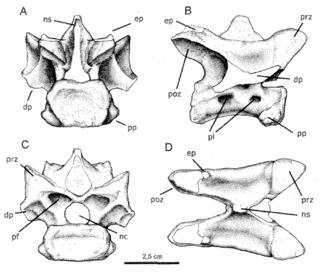
Laevisuchus is a genus of theropod dinosaur from the Late Cretaceous. Its remains were discovered by Charles Alfred Matley near Jabalpur in Maastrichtian "Carnosaur Bed" deposits in the Lameta Formation in Madhya Pradesh, central India, and were named and described by paleontologists Friedrich von Huene and Matley in 1933.
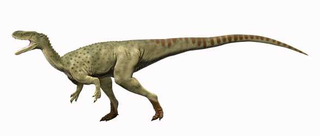
Spinostropheus is a genus of carnivorous neotheropod theropod dinosaur that lived in the Middle Jurassic period and has been found in the Tiouraren Formation, Niger. The type and only species is S. gautieri.

Noasauridae is an extinct family of theropod dinosaurs belonging to the group Ceratosauria. They were closely related to the short-armed abelisaurids, although most noasaurids had much more traditional body types generally similar to other theropods. Their heads, on the other hand, had unusual adaptations depending on the subfamily. 'Traditional' noasaurids, sometimes grouped in the subfamily Noasaurinae, had sharp teeth which splayed outwards from a downturned lower jaw.
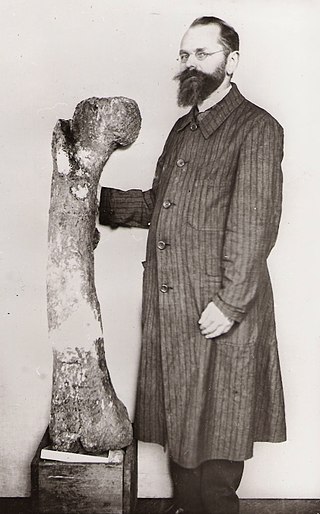
Bahariasauridae is a potential family of averostran theropods that might include a handful of African and South American genera, such as Aoniraptor, Bahariasaurus, Deltadromeus, and Gualicho. The placement of these theropods is controversial, with some studies placing them as basal ceratosaurs possibly related to Noasauridae, others classifying them as megaraptorans, basal neovenatorids, or basal coelurosaurs. There is also a possibility the group might not be monophyletic, as a monograph on the vertebrate diversity in the Kem Kem Beds published in 2020 found Bahariasaurus to be nomen dubium. In the same paper Deltadromeus is classified as an noasaurid, a result also recovered by some previous studies. A 2024 analysis found Aoniraptor, Bahariasaurus, Deltadromeus, Elaphrosaurus and Gualicho to form a monophyletic clade at the base of Ceratosauria.

Limusaurus is a genus of theropod dinosaur that lived in what is now China during the Late Jurassic, around 161 to 157 million years ago. The type and only species Limusaurus inextricabilis was described in 2009 from specimens found in the Upper Shishugou Formation in the Junggar Basin of China. The genus name consists of the Latin words for "mud" and "lizard", and the species name means "impossible to extricate", both referring to these specimens possibly dying after being mired. Limusaurus was a small, slender animal, about 1.7 m in length and 15 kg (33 lb) in weight, which had a long neck and legs but very small forelimbs. It underwent a drastic morphological transformation as it aged: while juveniles were toothed, these teeth were completely lost and replaced by a beak with age. Several of these features were convergently similar to the later ornithomimid theropods as well as the earlier non-dinosaurian shuvosaurids.

Dahalokely is an extinct genus of carnivorous abelisauroid theropod dinosaur from the Late Cretaceous (Turonian) of Madagascar.

This timeline of ceratosaur research is a chronological listing of events in the history of paleontology focused on the ceratosaurs, a group of relatively primitive, often horned, predatory theropod dinosaurs that became the apex predators of the southern hemisphere during the Late Cretaceous. The nature and taxonomic composition of the Ceratosauria has been controversial since the group was first distinguished in the late 19th century. In 1884 Othniel Charles Marsh described the new genus and species Ceratosaurus nasicornis from the Late Jurassic Morrison Formation of the western United States. He felt that it belonged in a new family that he called the Ceratosauridae. He created the new taxon Ceratosauria to include both the Ceratosauridae and the ostrich-like ornithomimids. The idea of the Ceratosauria was soon contested, however. Later that same decade both Lydekker and Marsh's hated rival Edward Drinker Cope argued that the taxon was invalid.

Afromimus is a genus of theropod dinosaur from the Early Cretaceous Elrhaz Formation of Niger. It contains a single species, A. tenerensis, named in 2017 by Paul Sereno from parts of the right leg, vertebrae, and ribs found in the Ténéré Desert. It was originally classified as an ornithomimosaurian, but subsequently it was argued to be an abelisauroid.



































